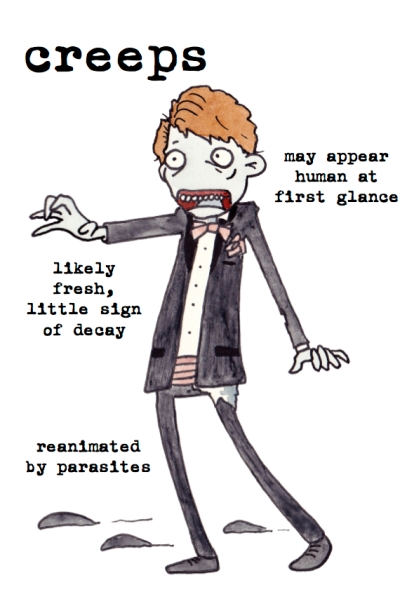As I’ve been looking around at other stories, games, movies etc. I’ve noticed a lot of different kinds of zombies out there.
Thanks to the spread of zombies in pop cultures the stakes seem higher than ever to create horrible nasties that stand out from the crowd. Viewers and creators are no longer totally satisfied with just having fast zombies or slow zombies, or flesh eaters and brain eaters. Now we have Nazi zombies to contend with, exploding zombies, super zombies, giant zombies etc. It all gets to be a bit much after a while. So here I’ve collected a solid batch of information based on dubious research into the field of the undead in an attempt to catalogue the various types of zombies in the world today.
To set things straight I define four basic types of zombies:
1. Chemical Zombies: Those reanimated due to the use of some sort of toxin.
Medical Zombies: Most typical type today. Infection is spread through blood or air born virus to infect the living. (I consider this a subgroup of Chemical zombies as bio-chemistry is simply another branch of chemistry. There is still some debate among scholars however and many consider these a separate group all together.)
2. Radiation Zombies: Zombies reanimated due to radiation. The classic Romero zombies were brought back due to radiation from a space probe.
3. Parasite Zombies: Caused by a worm or other parasite inhabiting and controlling the host body.
4. Supernatural Zombies: These include religious and magical zombies. Those brought back by wizards or gods for whatever purpose.
Other types of zombies, such as Nazi zombies, partials, crawlers, arms, dogs etc. are all variations on these four or five main types.

This zombie has been reanimated through some sort of biochemical means. Perhaps a virus or other pathogen.
Whether he was brought back through the use of a chemical or a biological infection, he’s here and he needs to be dispatched. It’s good to be aware of what type zombie you are dealing with so as to reduce the risk of infection to yourself and those around you. Remember how easily the father became infected with “rage” in 28 Days Later? You don’t want that happening to you and yours now do you? No. So do what you have to to keep these zombies at a distance and watch for signs of infection in yourself and those around you.
This might sound a bit uncommon as many of the recent zombie pictures focus on disease carriers. This is more a reflection of popular culture as we live in a world where diseases like AIDS, SARS, N1H1, Avian flu and all those good things are in the headlines. This makes it easier to for us to accept the disease zombies.
But when Romero’s Night of the Living Dead came out the world was in the throws of nuclear panic. (Not that we are too far off of that these days either.) After a recent re-watching of the Night of the Living Dead I was reminded that all of Romero’s zombies were brought back by radiation carried from a space probe from Venus. (Thanks NASA.)
So be on the lookout for signs of radiation poisoning, fallout warnings or other signs of radiation. In the event that radioactive zombies do come into being it’s likely that you won’t even realize radiation is the culprit until it’s too late so prepare ahead of time by being informed and knowing what to do in case of radiation.
Reanimation by way of parasitic infestation is a terrifying form of zombification though not one of the most common in mammals.
Remember Night of the Creeps? It was a pretty goofy but fun zombie flick back in the 80′s.
The story was based around parasitic organisms from space that entered the human brain, laid eggs, gestated, then burst out destroying the host. If the host were dead, even long dead, the parasitic little slugs would still be able to reanimate the body into a fierce threat. Most of their victims were the recently dead or the unwilling living which is why I noted above that the “Creeps” would likely be the recently deceased. In some cases these creeps were even mistaken for humans.
For more on how parasites can “zombify” the living check out my early post on Zombie snails.
One of the underlying problems with zombies is defining why they are the way they are. The movies have given us all sorts of explanations from chemicals to alien slugs in our bodies. The Hatian voodoo zombies were some of the first to be put on the silver screen in 1932′s White Zombie. There, they were recently deceased forced back to life with the help of voodoo and forced into labor. In some stories about them including White Zombie, Haitian zombies aren’t dead, they are simply the mesmerized victims of a voodoo curse. (For more on White Zombie check out my post here.)
By their nature zombies defy logic in that the damage they take from rotting or being attacked would stop any “living” thing. Loss of fluids would mean improper chemical reactions in the body and limited brain activity. Yet zombies keep on going despite all that. It’s an illogical but fun and magical story telling element.
I’ll be honest and say I think magic is pretty much a crock of shit. (And yeah I know how silly it is to be posting that sort of statement on a blog about zombies in the first place.) Regardless of my own biased disregard for the magical or semi-religious, it is a strong element in the telling of zombie tales and like all things religious it’s a great way to explain away all things logical.





You must be logged in to post a comment.